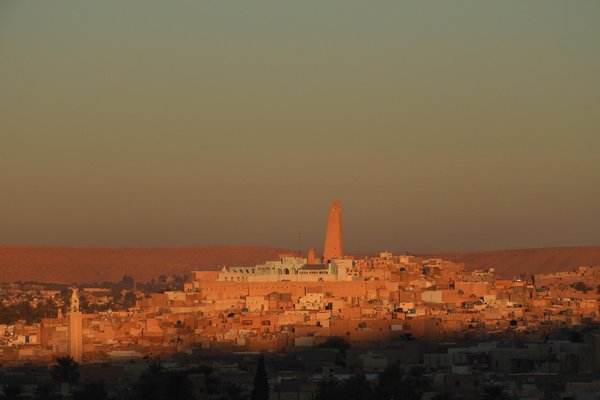Algeria
M'Zab Valley
The M'Zab Valley in the northern Sahara holds five traditional fortified villages (ksour), which are perfectly adapted to their environment and where the traditional building techniques have been kept up.
The Ibadis settled here from the 11th century on, making the most of the defensive possibilities and creating a water distribution system to make life in the semi-desert possible. Their settlements were built around a citadel and included palm groves. The five ksour included are El Atteuf, Bou Noura, Beni Isguen, Melika, Ghardaia.
Community Perspective: one of the most interesting areas in Algeria, with Ghardaia as the main component. The area has been prone to ethnic clashes in the past and a guide is obligatory to enter the walled cities.
Site Info
Official Information
- Full Name
- M'Zab Valley (ID: 188)
- Country
- Algeria
- Status
-
Inscribed 1982
Site history
History of M'Zab Valley
- 1982: Inscribed
- Inscribed
- Type
- Cultural
- Criteria
- ii
- iii
- v
Links
- UNESCO
- whc.unesco.org
- Official
-
- opvm.dz — Site by OPVM
- Related
-
- en.wikipedia.org — M'Zab Valley by Wikipedia
- chris-kutschera.com — The changing world of Mzab
All Links
UNESCO.org
- whc.unesco.org — whc.unesco.org/
Official Website
- opvm.dz — Site by OPVM
Related Resources
- en.wikipedia.org — M'Zab Valley by Wikipedia
- chris-kutschera.com — The changing world of Mzab
News Article
- July 9, 2015 ibtimes.co.uk — 18 dead in M'Zab valley communal violence
- Feb. 14, 2015 ocnus.net — Berber-Arab Clashes in Algeria's M'Zab Valley
- Oct. 4, 2008 ap.google.com — 29 Algerians die in flash floods in M'Zab Valley
Community Information
- Community Category
- Urban landscape: Arabic and Middle Eastern
Travel Information
Guided Tour Only
Recent Connections
-
Poetic Quotations
Simone de Beauvoir "C'était un tableau … -
Named after a River
Wadi M'zab (Mzab River). The region has… -
Guided Tour Only
A guide (from the main gate or the tour…
Connections of M'Zab Valley
- Geography
-
-
Sahara
The M'Zab Valley is located within the limits of the Sahara desert, six hundred kilometers to the south of Algiers. (AB Ev)
-
- Trivia
-
-
Minority communities
Ibadi Muslims
-
- History
-
-
Berbers
The local language of the Mzab is Mozabite (Tumẓabt), a branch of the Zenati group of Berber languages. -
Trans Saharan trade routes
From the 14th century, the M'zab region accentuated its role as a commercial caravan hub of Saharan Africa, around products such as wool, dates, salt, coal, weapons.See fr.wikipedia.org
-
Summer residences
"The living pattern of the Ibadis of the M'zab Valley included a seasonal migration. Each summer, the population settled in palm groves, where the "summer cities" were marked by the looser organization of their settlememts" AB. The structures include a summer citadel or Ksar -
Pentapolis
The fortified towns of Ghardaia, Bounoura, Melika, Beni Isguen and El Atteuf are often referred to as the "M'zab Pentapolis" as they are closely situated together in the Mzab valley and share the same culture/religion etc
-
- Architecture
-
-
Vernacular architecture
-
Designed by or influenced Le Corbusier
Le Corbusier visited in 1931 and this is credited with influencing the ideas for "La Ville Radieuse" and RonchampSee www.persee.fr
-
- World Heritage Process
-
-
Perfect Inscriptions
1982
-
- Religion and Belief
-
-
Jewish religion and culture
There was a Jewish presence in Ghardaia from at least the Middle ages. In 1962 around 2700 of the. by then. remaining 3000 were evacuated in a special operation at the time of Algerian independence because of fears for their safety. A Jewish cemetery and the ruins of a Synagogue can be seen in/around Ghardaia. See link -
Fortified religious buildings
Each citadel has a fortress-like mosque, whose minaret served as a watchtower.See en.wikipedia.org
-
Notable mosques
Central town mosques in each of the 5 ksours; 11th century (reconstructed); Ibadi -
Legends and Folk Myths
According to legend, Ghardaïa, means "Cave of Daïa" (Ghar Daïa); it is said that a young girl named Daïa lived alone in a cave. Sheikh Sidi Bou Gdemma passing by, was seduced by her beauty, they married and then founded Ghardaïa.See fr.wikipedia.org
-
- Human Activity
-
-
Irrigation and drainage
The palm groves are partly irrigated by an underground water distribution system called "Foggara". This is similar to the Iranian "Qanat" and the Omani "Aflaj" but only operates for flood waters. Its maintenance and operation is a significant element within the cultural life of the inhabitants. See -
Palm Groves
Crit v "The elements constituting the M'Zab Valley are an outstanding example of a traditional human settlement, representative of the Ibadis culture that, through the ingenious system for the capture and distribution of water and the creation of palm groves, demonstrates the extremely efficient human interaction with a semi-desert environment.
-
- Constructions
-
-
Mausolea
The M'Zab Valley counts several mausolea, e.g. for Sheikh Sidi Aissa in Melika and for Sheikh Ammi Brahim in El Atteuf.See fr.wikipedia.org
-
Cemeteries
Three unchanging elements are found in all 5 villages: the ksar, the cemetery and the palm grove with its summer "citadel". Outside the walls of the cities, the egalitarian idea reigns, as well, in the necropolises, where, among the nondistinctive graves, only the tombs of sages and the small mosques are distinguishable. (AB Ev) -
Walled cities
"Each of these citadels, encircled by walls...." (AB). -
Pyramids
The minarets of the mosques have a pyramidal form, e.g. those in Ghardaïa and El Atteuf.See fr.wikipedia.org
-
- WHS on Other Lists
-
-
Globally Important Agricultural Heritage Systems (GIAHS)
Oases of the Maghreb Algeria/Tunisia (pilot)See www.fao.org
-
- Timeline
-
-
Built in the 11th century
the standing sites originate from the early 11th Century
-
- Visiting conditions
-
-
Guided Tour Only
A guide (from the main gate or the tourist office) is officially needed to enter each of the walled towns.
-
- WHS Names
-
-
Named after a River
Wadi M'zab (Mzab River). The region has taken its name from the river.
-
- Literature & Film
-
-
Poetic Quotations
Simone de Beauvoir "C'était un tableau cubiste magnifiquement construit : des rectangles blancs et ocre, bleutés par la lumière, s'étageaient en pyramide; - la pointe de la colline était fichée de guingois une terre cuite jaune qu'on aurait crue sortie, géante, extravagante et superbe, des mains de Picasso.."
-
News
- ibtimes.co.uk 07/09/2015
- 18 dead in M'Zab valley communal v…
- ocnus.net 02/14/2015
- Berber-Arab Clashes in Algeria's M…
- ap.google.com 10/04/2008
- 29 Algerians die in flash floods i…
Recent Visitors
Visitors of M'Zab Valley
- AC
- Ali Zingstra
- Artur Anuszewski
- Atila Ege
- Bill Maurmann
- Boj
- Bram de Bruin
- edstar500
- Emili Xaus
- Fernweh
- George Gdanski
- Gernot
- Harry Mitsidis
- Iain Jackson
- Janos
- Jon Opol
- Juha Sjoeblom
- Loic Pedras
- Luis Filipe Gaspar
- Maciej Gil
- michaelsballard
- Miloš Tašković
- Nihal Ege
- Peltzi
- Pincze
- pressdm
- Roman Bruehwiler
- Solivagant
- Szucs Tamas
- Thomas Buechler
- Thomas van der Walt
- Timothy C Easton
- Weecheng
- wendy007
- Zach
- Zoë Sheng
Community Reviews
Show full reviews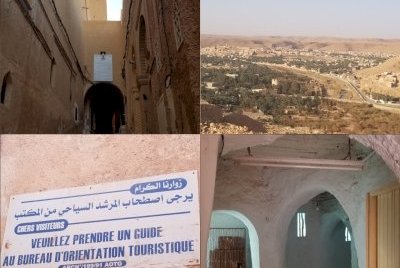
When you drive south on the Trans-Sahara highway and arrive at the valley you won't believe there is such a bustling town here, or rather, towns. The view is nice. I'm less impressed with the old towns though.
First off, you need a guide. There wasn't a guide, I would have liked one but I think these days they just don't have people hanging around waiting for tourists as there aren't any. I just walked in, no guards, nobody minded, as long as you keep walking and don't stare around like a tourist. It's easy to get lost in these narrow passages but it seems to keep going. Felt like a mix between other sites, but it did not feel special either. I think the tangible essence of the site is not very obvious and many places around the world have these kind of living conditions. I did not enter the mosque by the way, as there was another clear sign not to enter.
I went to one more afterwards and it was the same experience. They luckily spare these housing areas from all the new development springing up all over the valley, although we aren't talking skyscrapers so it's actually well done and keeps the valley looking the same. The whole visit I didn't see a single UNESCO sign.
Keep reading 0 comments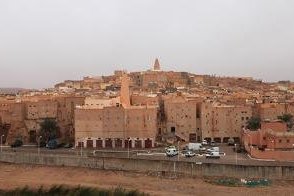
Site visited December 2013. My visit to M'Zab Valley WHS could be categorized ’nearly missed’ due to the riots that took place in Ghardaïa that time. But I consider it as visited though not extensively. In many aspects my visit became totally different than I had expected.
There were lot of things that went wrong on my trip. The problems started already when I flew from Constantine to Ghardaïa via Algiers. Air Algérie is notorious for its unreliability and I fell victim to that. The whole story is too long to tell here but all I want to say is that it was very eventful travel day. I was lucky that I made it to the Ghardaïa plane just before its departure.
I was happy when I arrived late in the evening in Ghardaïa but I was totally unaware what waited for me there. At the airport the policeman escorted me to the taxi. The hotel staff was a little bit surprised when they saw a tourist. Next morning they made it clear that they don’t let me out of the hotel on my own. They told me that the situation is very serious and it is not safe to visit the famous ksours. The receptionist said that there has been violent ethnic clashes between Arabs and Mozabite Berbers. She told that people throw cobblestones to shop windows, burn houses and dig bodies from the graves. There had been fatalities. The receptionist also said that she don't understand why this …
Keep reading 0 comments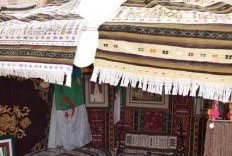
On a Friday there are no official guides at the entrance gate of the old city of Ghardaia, nevertheless it is compulsory, and I have to ask the help of the military and police officials. But luckily some diplomats from Algiers showed up, and I was able to join them, not only for Ghardaia, but also the sister village of Beni Isguen; we walk up to the local mosque, always the highest point of a Mozabite town. The paths are very narrow, good for donkeys, but nothing else. In summer time when the temperatures rise to above 50 degrees, the locals relocate to the palm oasis below. We also visit the cemetery where ‘another one bites the dust’ does not have to be further explained, there are no graves, no flowers, just stones and sand from the Sahara. Beni Isguen is home to the Mozabite women, clad entirely in white, and revealing only one eye to the outside world.
Keep reading 0 comments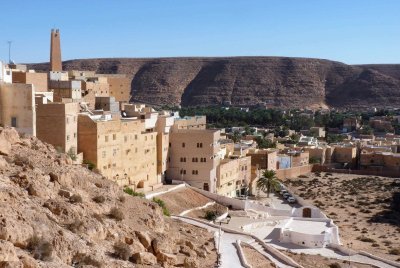
The 5 inscribed towns of the M’zab valley are, despite the lack of tourists currently visiting Algeria, one of its (relatively) “honey pot” sites and about the only place where we met other tourists in Dec 2012. What draws them is primarily the feeling that one is entering a closed society as evidenced in both the design and architecture of the towns and the culture of their people. The architecture is regarded as having influenced a number of modern architects – particularly Le Corbusier who visited in 1931 and 33 (at least, since he spent a lot of time in Algeria). The culture is that of the Mozabite people - a Berber tribe, most of whom are Ibadi Muslims. They reached the M’zab valley around 1010 AD after being expelled by the Sunni Fatamids from their earlier home in the north which had become Ibadi around 770 AD under the Rustamid dynasty which had a Persian origin (today the World’s largest Ibadi community is in Oman). The circumstances of their choice of M’zab came about from the need for defense and security – the hills above the valley are still scattered with watch towers, the towns are designed as fortresses and partaking in the overnight guard duty is still an important aspect of Mozabite male culture. They remained independent through to the 19th C, first concluding an agreement with France in 1853 to maintain it and finally succumbing in 1882. Ibadi religious belief favours “dissociation” from (but not hostility towards) …
Keep reading 0 comments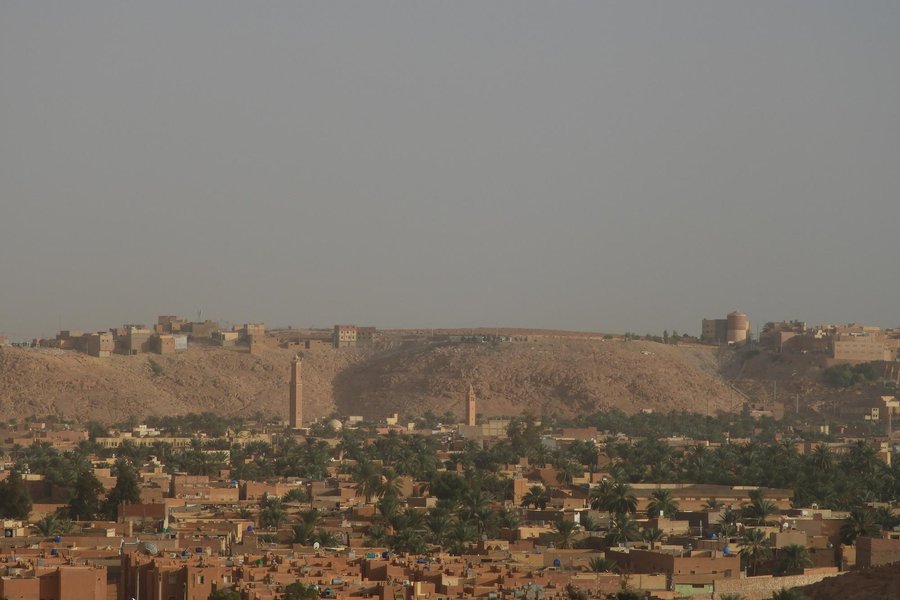
My visit here was in 1991 so memories have faded somewhat after more than 16 years. I do know however that this is one of the most interesting areas in Algeria and should be on the itinerary of anyone visiting the country. Five small towns, of which Ghardaia is by far the largest, sit in a valley surrounded by barren desert.The valley has thousands of palm trees and a complex water supply system. I also visited two other of the towns, Beni Isguen and Melika.
The people here tend to have held themselves apart from the main current of Algerian history and are Berber with conservative religious views. The men wear (wore?) the low hanging baggy trousers as seen in parts of rural Turkey while the women dress in an allover white garment folded in such a way that only one eye is visible.
Each town stands on top of a small hill with its mosque, usually with a distinctive pyramidal minaret, at its centre. Most of the buildings are cream painted and well maintained. There are alleyways and daily markets (in which dates figure very large) to explore and in Beni Isguen a museum of local life. Locally painted signs advise the visitor on the modest dress expected to be worn.
Not many laughs here perhaps but with an atmosphere unlike anywhere else I saw in Algeria.
Keep reading 0 comments
